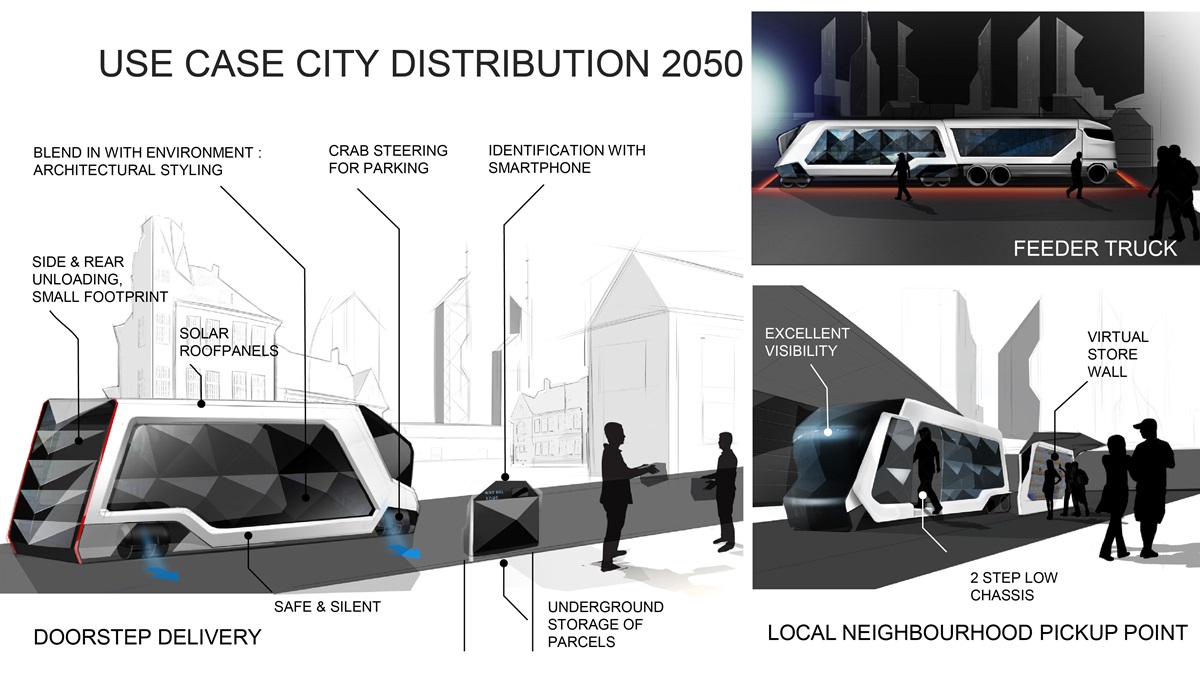

Urban distribution in 2050:
Back to the future
Bart van Lotringen
What would happen if you gave a truck designer the freedom to do exactly what he likes? If for once they were not restricted by the limits of technology or legal regulations? DAF designer Bart van Lotringen decided to take this approach to the topic of urban distribution in 2050. His concept is revolutionary, but surprisingly enough it has its roots in history, too. Back to the future in other words.
Before he explains his concept, Bart van Lotringen paints a quick picture of the various social and technological developments currently at play. “We are moving towards a 24/7 economy in which everything has to be faster and more efficient,” he says. “We are getting more and more used to purchasing the things we need online, everything from shoes to groceries. Urban landscapes are changing: there are less shops in our city centres, even though the number of people living in cities continues to rise due to increased urbanisation. Cars are also being banned from city centres in order to make urban spaces more liveable.”
Local and Social
It is very convenient, of course, that we don’t even have to leave our house anymore to purchase whatever it is we need. Not to mention the fact that you can have your purchases delivered right to your door within a few hours by courier or by drone. However, there is a negative aspect to this too, explains Van Lotringen. “People will always have a need to maintain social contact with other people. The picture I have just painted tells a different story, however; we are venturing outside our front doors less and less and interacting with other more often via computer screens.” And there is another negative aspect to these developments, says Van Lotringen: “Sometimes, because of our busy careers, we are not able to be around to collect a delivery when the courier arrives at our door. That means we have to collect the delivery ourselves at a local pick-up point later on.
Not very efficient and not good for the environment either. So new distribution concepts have been introduced in which goods are delivered directly to a central pick-up point instead, such as a supermarket with longer opening hours.”

Electric and hybrid
The transport (or more precisely distribution) concept proposed by Van Lotringen takes into consideration the human need for social contact while at the same time ensuring the lowest possible ecological footprint. “In our vision, people will continue to do their shopping online, probably to an even greater extent. However, their purchases will not be delivered automatically to their door. Instead, goods will first be transported by long-haul trucks to distribution centres located outside the city. There they will be loaded onto ‘feeder trucks’ – large combinations with diesel-hybrid drivelines – before being transferred just outside the city centre onto a compact distribution truck that has been adapted to meet the new requirements for driving in the city centre.”
Fully electric
The distribution truck referred to by Van Lotringen is fully electric, which means quiet and emission-free. The truck operates 24/7 delivering goods in the city centre. Customers receive messages on their smartphones informing them of the truck’s location and the status of their delivery. “What we are doing, in fact, is creating a ‘corner shop’ where people can come together, just like they used to,” says Van Lotringen. “They come to pick up their deliveries, but they can also buy their groceries in a virtual shop at the same location using a large screen that also serves as the ‘bus stop’ for the
distribution truck.”
Part of the landscape
The distribution truck is designed in such a way that it becomes a natural part of the urban landscape. This is achieved through the use of features like transparent bodywork, for example. The truck’s wheels have a 90-degree rotation feature that allows it to move sideways, which provides for optimal manoeuvrability in restricted spaces in the city. The low floor allows customers to walk effortlessly inside, while the solar panels on the roof provide the required energy. And DAF would not be DAF if the driver’s needs were not taken into consideration, too. Van Lotringen: “A panoramic windshield provides an all-round view, which enables the driver to make and maintain eye contact with pedestrians. And, of course, the driver is also supported by safety systems and cameras, which are essential in busy city centres.”
Realistic?
How realistic is Van Lotringen’s idea? Willwe ever see this happen ‘for real’? “As a manufacturer you always have to keep thinking about the future,” he says. “The aim of this concept is to facilitate a dialogue with our customers and to start a discussion about their own future developments and the role our trucks can play in that. It is unlikely that this concept will ever become one hundred per cent reality. But certain parts of it will certainly be adopted. No one can predict the future, but I am pretty sure about a few things: that humans cannot survive without social contact and that there is an increasing awareness that we have to take care of our planet. This concept fits those needs perfectly.” ■

Bart van Lotringen
“We are moving towards a 24/7 economy in which everything has to be faster and more efficient,”

